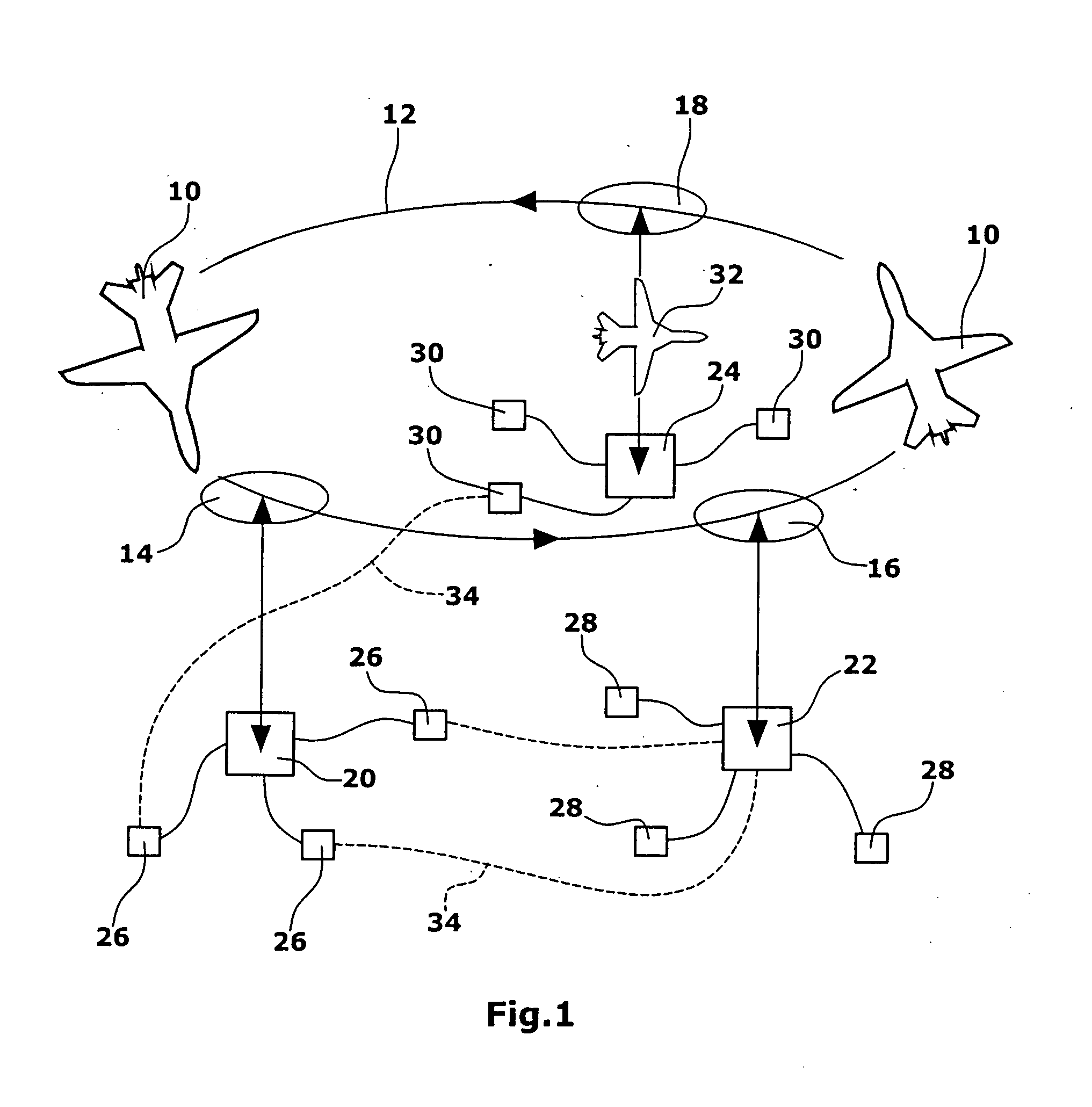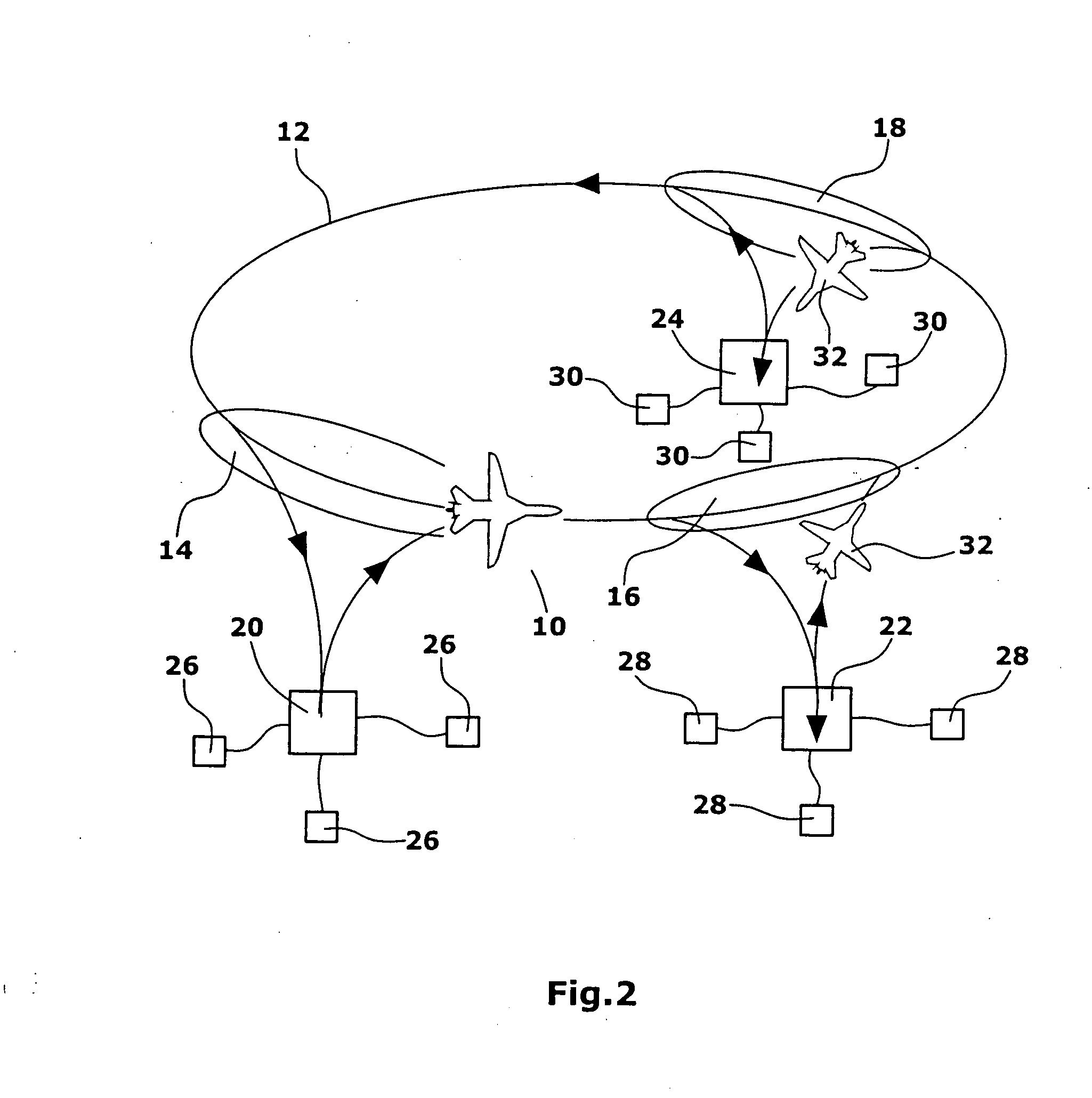[0007]The present disclosure provides an air cargo transportation method, a transport plane and an air cargo transport
system with which the transport of air cargoes to different destinations can be effected more economically, in particular without repeated reloading.
[0009]The feeders have a transport capacity which may in particular be less than that of the transport plane so that the feeders have a relatively low wing load. Moreover, the feeders, possibly a plurality thereof, can transport various cargoes for different destinations to the transport plane, the transport plane preferably consisting of a plurality of feeders. When transporting from a respective transport plane to a respective
station, preferably only cargo having exactly one destination is transported, the destination being associated to the respective
station to which the feeder flies. The air cargo transportation method of the invention allows to provide only exactly one take off and only exactly one landing procedure for each individual cargo item. Thus, repeated starting and landing with a certain cargo is avoided so that the fuel consumption of the transport plane is reduced. Further, lifting and landing the various cargoes is effected using the feeders, so that the transport plane needs not take off or land, thereby further reducing fuel consumption. In addition, due to their transport capacity, which in particular is smaller than that of the transport plane, the feeders can start from and land at airports not designed for the take off or landing of the transport plane. Thereby, it is possible to make the flight
route scheduling of the transport plane more variable and, in particular, it can be fixed such that the transport ways and transport times can be shortened, respectively. The air cargo transport can thus be decentralized so that in particular large airports with a high
traffic volume and corresponding long waiting times can be avoided. Using a physical
transportation infrastructure, such as roads, rails, waterways, is avoided or at least significantly reduced. Further, the feeders employed may be, for example, helicopters or vertical take off planes that require particularly little space for taking off and landing, so that it is not necessary to provide the stations with airports and their accompanying extensive infrastructure. In particular when using helicopters or vertical take off planes as feeders, the take off and landing site of the feeder can be the same station so that the logistic effort is reduced.
[0013]According to an independent invention, the small plane is substantially composed of a receptacle, especially a container, connected to wings and / or a propelling unit. Preferably, the container is a standard container which may, for example, also be transported by ship,
train or
truck, and has the standard dimensions necessary for this purpose. The wings and / or the propelling unit are preferably removably or detachably connected with the container, e.g. through clamping, snapping or plug-in connections. Thus, the small plane is substantially designed as an “airworthy container” so that the technical features required for flight purposes can be reduced to a minimum, whereby the capital burden incurred by maintaining a vehicle fleet for the air transportation of goods is drastically reduced because of the less expensive technology, thereby improving upon the efficiency. Preferably, the small planes may be physically connected especially via the receptacle or container either in line, side by side and / or in stacked relationship. Preferably, the feeders are connected in line or side by side so that the thrust of the rearmost or outermost feeder can propel the feeders interconnected to form the transport plane. The feeders at front will be pushed forward, not pulled, so that rigid connections such as screw connections for a transfer of traction forces are not required and loose connections such as contacting thrust faces are sufficient as a physical connection.
[0015]Especially if fuel for refueling or for the
energy supply of the transport plane in the air is transferred during the transfer of cargo, refueling stops of the transport plane can be avoided, since the transport plane can be refueled while in air. This makes it possible to refuel the transport plane or the feeders forming the transport plane in a simple and economic manner using a single further light feeder. For exampie, it is possible that a single feeder of the transport plane provides
electric power to supply electric motors of the other feeders through
electric cables so that, for a “refueling” of the transport plane, only the feeder comprising the
electric power supply has to be replaced. Preferably, the transport plane composed of a plurality of feeders comprises exactly one feeder that supplies power or fuel to the other feeders so that only this feeder has to be supplied with power or fuel to provide power or fuel to all feeders forming the transport plane. In particular, this allows to provide power generators and / or fuel tanks substantially only in this one feeder so that the
fuel tank or the
power storage means, such as batteries, of the other feeders may be considerably reduced. Especially, it is possible to provide only as much fuel or power in the other feeders as is required as braking power when landing so that the own weight of the other feeders is relatively low compared to the
payload.
[0017]The invention further relates to a transport plane for the
air transport of cargo, with which, in particular, the air cargo transportation method described above can be executed. According to the invention, the transport plane has a first feeder and a second feeder which are connected to form the transport plane. Preferably, the first feeder has a first wing and the second feeder has a second wing so that the two feeders are interconnected through a rigid connection of the first wing to the second wing. Moreover, the feeders, especially embodied by small planes, may be connected through cargo transport locks for the transport of cargo between the two feeders so that, in particular, it is possible to sort the cargo while in air. The cargo transport lock is located especially in the region of the rigid connection of the small planes so that, for example, cargo arranged in the wings can be exchanged in a simple manner. In particular, the cargo capacity of the transport plane can be adapted to the current
transport volume through the number of feeders used to form the transport plane.
[0019]Using the present air cargo transport
system, it is possible to improve upon the utilization time of the plane by reducing down times on the ground, thereby enhancing the transport of air cargo.
 Login to View More
Login to View More  Login to View More
Login to View More 


